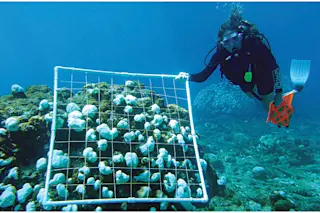There’s a ditty for this, but all I can think of are kid’s tunes.
I need a good manly sea song because I am doing a manly thing. Legs spread against the roiling San Diego Bay swell, stomach calmed by a manly dose of Dramamine and a shooter of Zantac,
I narrow my eyes against a warm California sun and size up the black silhouette of the USS Pogy as it slices its way through Pacific waters to greet our trim little craft.
Aye, we are seven journalists strong, faring to sea to board this nuclear submarine and see what it is made of (steel, mostly, as it turns out). The ride on the sub is courtesy of the U.S. Navy, specifically comsubpac, which stands for Commander Submarine Force, U.S. Pacific Fleet. The Navy wants to publicize its role in scicex 96, which stands for Arctic Submarine Science Cruise. And ...














